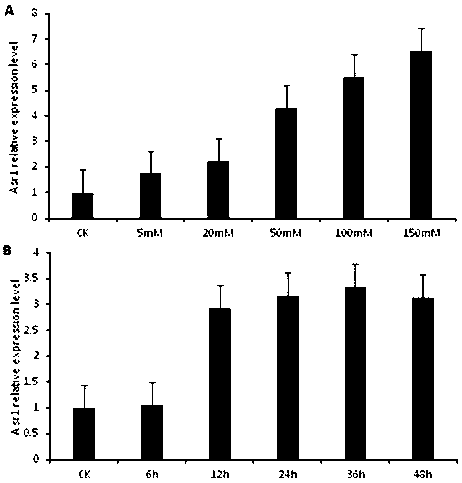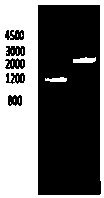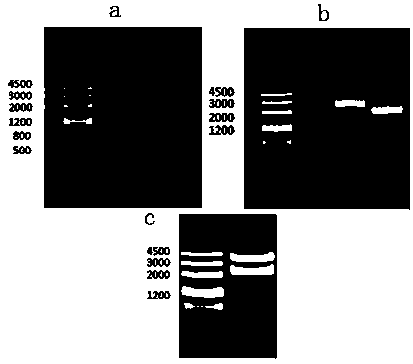C2H2-type transcription factor gene and application thereof
A transcription factor and gene technology, applied in the field of genetic engineering, can solve the problems of incomplete recognition and binding of target genes, and achieve the effects of low technical cost, small environmental impact, and easy operation
- Summary
- Abstract
- Description
- Claims
- Application Information
AI Technical Summary
Problems solved by technology
Method used
Image
Examples
Embodiment 1
[0023] Example 1: Cryptococcus terrestris ( C . humicolus ) Extraction of total RNA from strain BSLL1-1 and synthesis of cDNA
[0024] Use TRIzoL kit (TaKaRa company) to extract total yeast RNA. The steps are as follows: Take about 0.2 g of Cryptococcus terrestris, add it to a mortar and grind it with liquid nitrogen to a powder, then add 1 mL of TRIzoL extract Continue to grind until clear. Transfer the grinding solution to an EP tube, let stand at room temperature for about 5 minutes, add 0.2 mL of chloroform and shake vigorously for 1 minute, then place the sample on ice for 5 minutes, centrifuge at 12000 rpm 4°C for 15 minutes; transfer the supernatant to a new EP In the tube, another extraction was performed with chloroform. Take the supernatant and add an equal volume of isopropanol. After standing at -20°C for 0.5 h, centrifuge at 12000 rpm, 4°C for 30 min; discard the supernatant, wash twice with 1 mL of 75% ethanol, 12000 rpm, 4°C for 5 min, pour out the ethanol. Aft...
Embodiment 2
[0034] Example 2: Fluorescence quantitative PCR analysis asr1 Gene expression under aluminum stress
[0035] Design real-time PCR primers for the 18S rRNA and C2H2 type transcription factor Asr1 encoding genes of Cryptococcus terrestris. The 18S rRNA gene is used as an internal reference. The primer sequences are as follows:
[0036]
[0037] Use SYBR Premix Ex TaqII (Tli RNaseH Plus) kit for real-time PCR, the reaction system is 20 µL (see the table below), and the Applied Biosystems 7500 Fast Real-Time PCR System uses a two-step PCR reaction program: Stage 1: pre-denaturation, Reps : 1,95 ℃ 30 s; Stage 2: PCR reaction, Reps: 40, 95 ℃ 5s, 60 ℃ 30 s; after the reaction, confirm the amplification curve and melting curve of real-time PCR, and make standard curve when performing PCR quantification Wait.
[0038]
[0039] With 18S rRNA gene as the internal control, the gene expression of the concentration gradient experimental group without aluminum ion culture for 48 h was used as t...
Embodiment 3
[0042] Example 3: Asr1 transcription factor asr1 Gene cloning and sequencing
[0043] Using Cryptococcus terrestris cDNA as a template asr1 PCR amplification of genes, the amplified primers are forward: AAGCTT ATGCCGCCTGGACCGTCACCCAAAGAT (underlined Hind Ⅲ restriction site), reverse: GGATCC CTAGAATGGGCATGGCCCACATTCGTT (underlined BamH Ⅰ restriction site). Reaction conditions: first pre-denaturation at 94 ℃ for 3 min, then 30 cycles of 94 ℃, 30 S, 62 ℃, 30 S, 72 ℃, 2 min, and extension at 72 ℃ for 10 min after the end of the cycle. The obtained PCR amplification products were subjected to agarose gel electrophoresis ( figure 2 ), use DNA gel recovery kit to purify the target band. Connect the target fragment to the pMD18-T vector to obtain a recombinant vector pMD18-T- containing the target fragment asr1 . It was transformed into E. coli competent cells DH5α by heat stimulation, and then spread on the LB solid plate containing ampicillin, and inverted at 37 ℃ for about 12...
PUM
 Login to View More
Login to View More Abstract
Description
Claims
Application Information
 Login to View More
Login to View More - R&D
- Intellectual Property
- Life Sciences
- Materials
- Tech Scout
- Unparalleled Data Quality
- Higher Quality Content
- 60% Fewer Hallucinations
Browse by: Latest US Patents, China's latest patents, Technical Efficacy Thesaurus, Application Domain, Technology Topic, Popular Technical Reports.
© 2025 PatSnap. All rights reserved.Legal|Privacy policy|Modern Slavery Act Transparency Statement|Sitemap|About US| Contact US: help@patsnap.com



